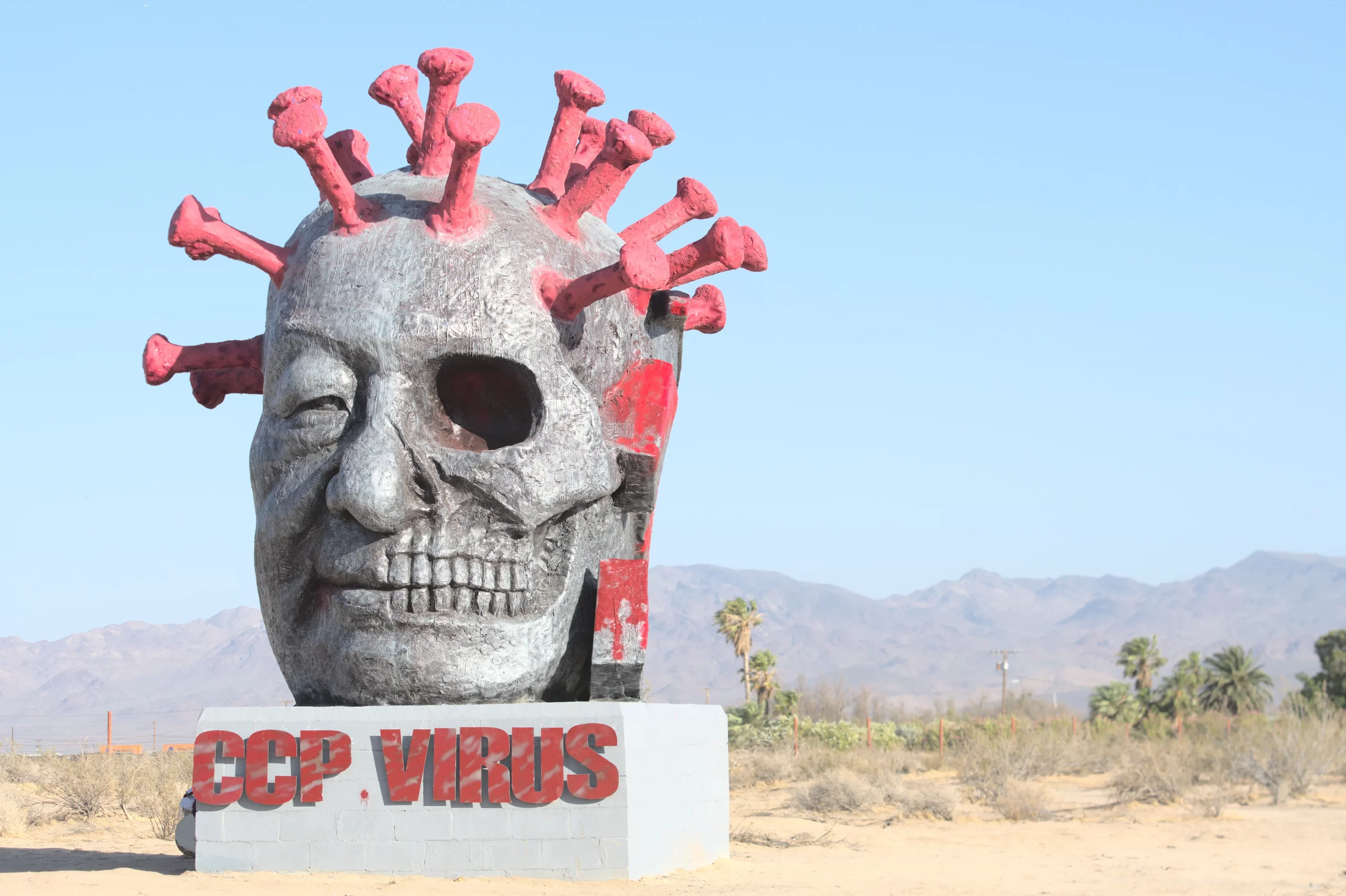As humans have spread across the world, so have infectious diseases. Even in this modern era, outbreaks are nearly constant, though not every outbreak reaches pandemic level as COVID-19 has.
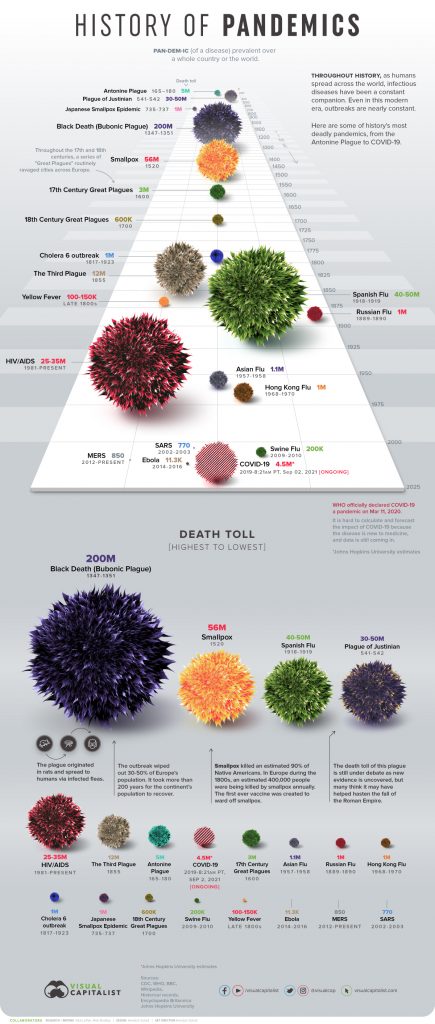
1. A Timeline of Historical Pandemics
Disease and illnesses have plagued humanity since the earliest days, our mortal flaw. However, it was not until the marked shift to agrarian communities that the scale and spread of these diseases increased dramatically. Widespread trade created new opportunities for human and animal interactions that sped up such epidemics. Malaria, tuberculosis, leprosy, influenza, smallpox, and others first appeared during these early years.
The more civilized humans became – with larger cities, more exotic trade routes, and increased contact with different populations of people, animals, and ecosystems – the more likely pandemics would occur. Here are some of the major pandemics that have occurred over time:
| Name | Time period | Type / Pre-human host | Death toll |
|---|---|---|---|
| Antonine Plague | 165-180 | Believed to be either smallpox or measles | 5M |
| Japanese smallpox epidemic | 735-737 | Variola major virus | 1M |
| Plague of Justinian | 541-542 | Yersinia pestis bacteria / Rats, fleas | 30-50M |
| Black Death | 1347-1351 | Yersinia pestis bacteria / Rats, fleas | 200M |
| New World Smallpox Outbreak | 1520 – onwards | Variola major virus | 56M |
| Great Plague of London | 1665 | Yersinia pestis bacteria / Rats, fleas | 100,000 |
| Italian plague | 1629-1631 | Yersinia pestis bacteria / Rats, fleas | 1M |
| Cholera Pandemics 1-6 | 1817-1923 | V. cholerae bacteria | 1M+ |
| Third Plague | 1885 | Yersinia pestis bacteria / Rats, fleas | 12M (China and India) |
| Yellow Fever | Late 1800s | Virus / Mosquitoes | 100,000-150,000 (U.S.) |
| Russian Flu | 1889-1890 | Believed to be H2N2 (avian origin) | 1M |
| Spanish Flu | 1918-1919 | H1N1 virus / Pigs | 40-50M |
| Asian Flu | 1957-1958 | H2N2 virus | 1.1M |
| Hong Kong Flu | 1968-1970 | H3N2 virus | 1M |
| HIV/AIDS | 1981-present | Virus / Chimpanzees | 25-35M |
| Swine Flu | 2009-2010 | H1N1 virus / Pigs | 200,000 |
| SARS | 2002-2003 | Coronavirus / Bats, Civets | 770 |
| Ebola | 2014-2016 | Ebolavirus / Wild animals | 11,000 |
| MERS | 2015-Present | Coronavirus / Bats, camels | 850 |
| COVID-19 | 2019-Present | Coronavirus – Unknown (possibly pangolins) | 2.7M (Johns Hopkins University estimate as of March 16, 2021) |
Note: Many of the death toll numbers listed above are best estimates based on available research. Some, such as the Plague of Justinian and Swine Flu, are subject to debate based on new evidence.
Despite the persistence of disease and pandemics throughout history, there’s one consistent trend over time – a gradual reduction in the death rate. Healthcare improvements and understanding the factors that incubate pandemics have been powerful tools in mitigating their impact.
September 2, 2021 Update: Due to popular request, we’ve also visualized how the death tolls of each pandemic stack up as a share of total estimated global populations at the time.
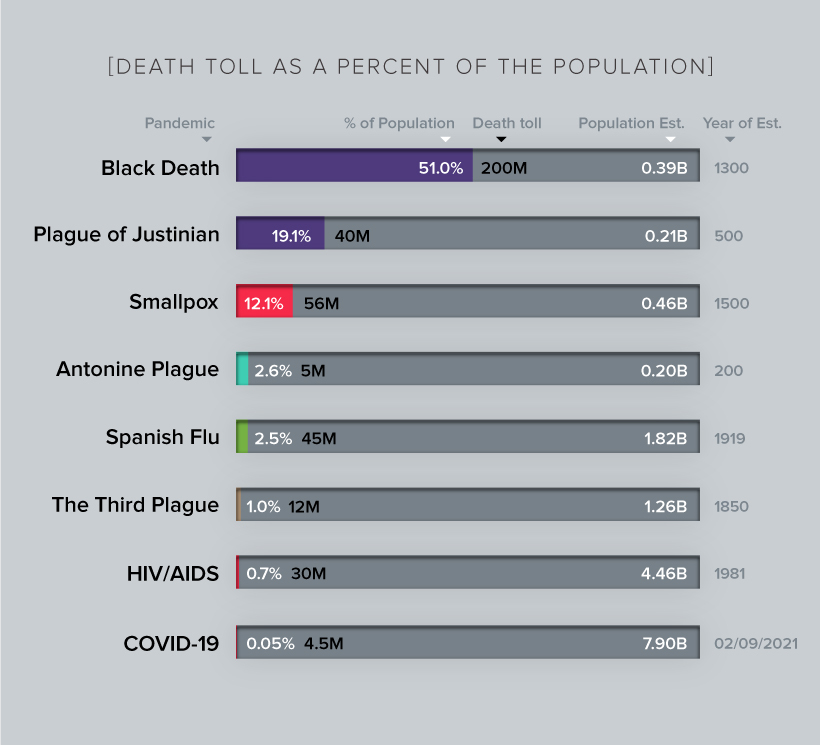
2. Tracking Infectiousness
Scientists use a basic measure to track the infectiousness of a disease called the reproduction number — also known as R0 or “R naught.” This number tells us how many susceptible people, on average, each sick person will in turn infect.
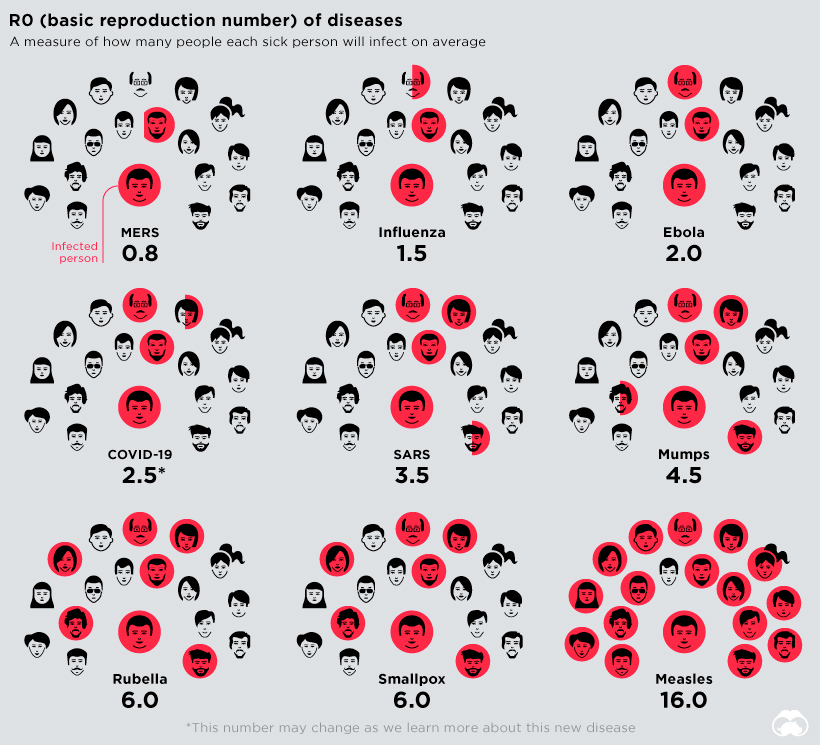
Measles tops the list, being the most contagious with a R0 range of 12-18. This means a single person can infect, on average, 12 to 18 people in an unvaccinated population. While measles may be the most virulent, vaccination efforts and herd immunity can curb its spread. The more people are immune to a disease, the less likely it is to proliferate, making vaccinations critical to prevent the resurgence of known and treatable diseases.
It’s hard to calculate and forecast the true impact of COVID-19, as the outbreak is still ongoing and researchers are still learning about this new form of coronavirus.
3. The history of the persecution of Christianity
According to historical records, the Roman Empire was struck with three epidemics, which were widely believed to have a close relationship with its history of persecuting Christians. The plague occurred the first of three times during the reign of King Nero in 65, and then King Marcus Aurelius from 164 to 180, and the commander-in-chief Gaius Claudius from 250 to 270. During those periods, Christians suffered from the most brutal persecution.
According to Eyewitnesshistory, Nero was the first emperor to start the persecution of Christians by blaming them for the great fire of Rome in the summer of 64. He then ordered the arrest of its members, imposed harsh torture on them, and “put them to death in the most horrific manner for the amusement of the citizens of Rome.”
After that, an epidemic, believed to be severe malaria, broke out claiming the lives of 30,000 urban residents in just one autumn, noted Roman historian Suetonius. During his reign starting in A.D. 161, King Antoninus Aurelius ordered that the heads and limbs of countless Christians be cut off and hung in the streets. To instigate the persecution, the Romans also slandered the Christians saying that they drank children’s blood.
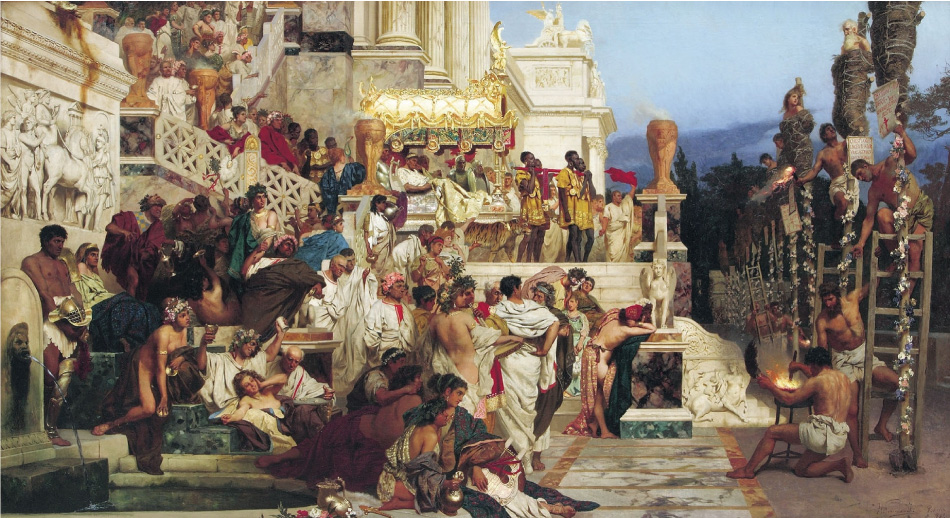
In 165, a disease erupted and was later known as “Antonine Plague” as it claimed the very life of King Aurelius. The pandemic lasted for nearly 20 years and affected the whole empire causing death to an estimated 5 million citizens, said BBC.
The Greek physician and writer Galen (129–c. 216 ), witnessed the outbreak and described its symptoms including “fever, diarrhea, vomiting, thirstiness, swollen throat, and coughing, and inflammation of the pharynx, along with dry or pustular eruptions of the skin.” His descriptions suggest that it was most likely smallpox.”
The third epidemic struck in 251, two years after Emperor Decius launched the attack of the Christians at an unprecedented level, as Bible Study Tools laid out. He issued an edict requiring public sacrifice to the gods and the emperor. Those refuting the order were subsequently put under arrest, imprisoned, tortured, and executed. Subsequently, numerous Christians, refusing to comply, were burned at the stake and thrown to beasts in arenas for amusement.
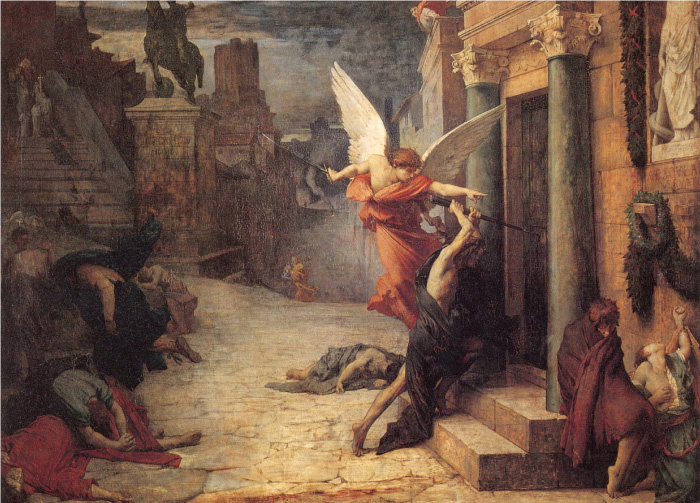
The plague lasted nearly 20 years until the ruling of Gaius Claudius and, at its height, reportedly killed as many as 5,000 people per day in Rome, noted The Atlantic. Decius also met a tragic end—killed in a war. Emperor Claudius, who furthered the persecution also died from the epidemic.
Consequently, many scholars have speculated and even concluded that the three pandemics were a severe punishment by God for persecuting the Christians. The emperors who ordered the persecution of the Christians all got retribution and died of infection.
Consequently, many scholars have speculated and even concluded that the three pandemics were a severe punishment by God for persecuting the Christians. The emperors who ordered the persecution of the Christians all got retribution and died of infection.
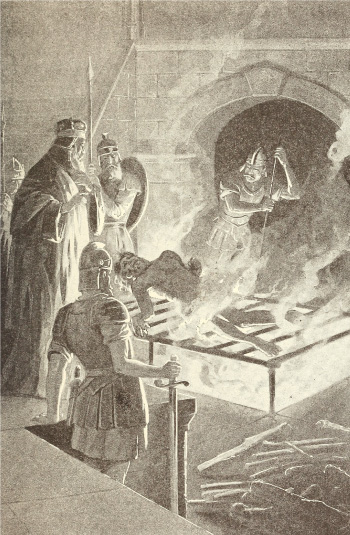
4. Religious persecution by the CCP
Historically, the Chinese Communist Party (CCP) has brought so many bloody massacres to its innocent religious followers:
With the promotion of state atheism, anti-religious campaigns were carried out between 1950 and 1979, precipitating the closure of churches, temples, and mosques, the confiscation of religious texts, and the killing and abuse of religious adherents.
In July 1999, the leader of the Chinese Communist Party at the time, Jiang Zemin, launched a brutal campaign to eradicate the practice of Falun Gong under this slogan: “Destroy their reputations, ruin them economically, and destroy them physically,” according to Nobel Peace Prize nominee and former Canadian Secretary of State for the Asia-Pacific region David Kilgour.

During the last 20 years, a massive number of followers of this ancient Chinese traditional discipline have suffered arbitrary arrest, detention, brainwashing, rape, torture, death, and the horrendous practice of forced organ harvesting, according to human rights lawyer David Matas, also nominated for the Nobel Peace Prize for co-authoring with Kilgour the research report “Bloody Harvest.”
The most recent anti-religious campaign was coordinated by current General Secretary of the Communist Party of China Xi Jinping, who re-emphasized that members of the Communist Party of China must be “unyielding Marxist atheists” and also instituted a broad campaign to suppress all forms of dissent.”
Activists have claimed that at least 1 million ethnic Uighurs and other Muslims are being held in detention centers in the Xinjiang region. The cache of leaked documents, as reported by the media, is proof that Chinese authorities are involved in a massive and systemic repression of Muslims and other minorities in western China.

5. The Wuhan crisis: Reminiscent of the collapse of the ancient Roman Empire
What happened during the outbreak of SARS and is recurring in Wuhan, China, today poignantly reminds us of the harsh crisis of the Roman Empire.
The SARS epidemic also originated in China and in eight months (November 2002 to July 2003) spread to 29 countries. It reportedly killed over 774 and sickened 8,098, said Business Insider. The mortality rate for SARS was 9.6%, yet, it is widely believed that the real severity of the disease outbreak was underreported by the Chinese regime.” Seventeen years later, the novel coronavirus plague hit Wuhan and has placed all cities of China on lockdown.
As an ancient saying goes, “Life and death are determined by Heaven.” So what will God rely on to determine the life and death of a being? It is based on cause and effect, virtue and karma of that individual. When a tribulation occurs, Nature is the fairest measure to determine whether a life is saved or not. In other words, people are responsible for their own words and actions.
Source:
1. https://www.visualcapitalist.com/history-of-pandemics-deadliest/?fbclid=IwAR2csBZO1KM-itX0VUJoIlbwuCEYHsYb6S3vc58uFiVsrD44HGCw2BP6EHg#new_tab
2. https://thebl.com/culture/coronavirus-outbreak-is-history-repeating-itself.html

